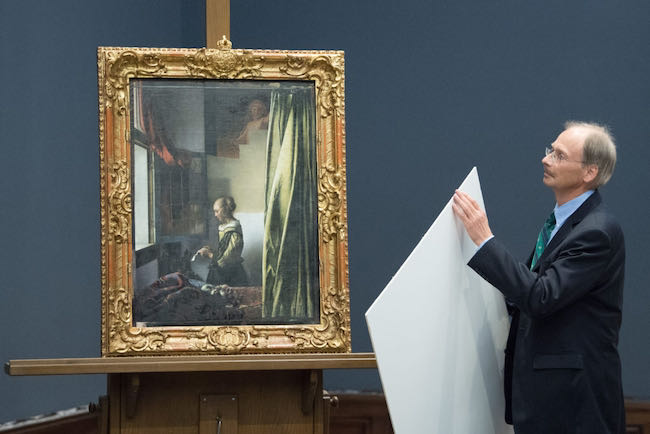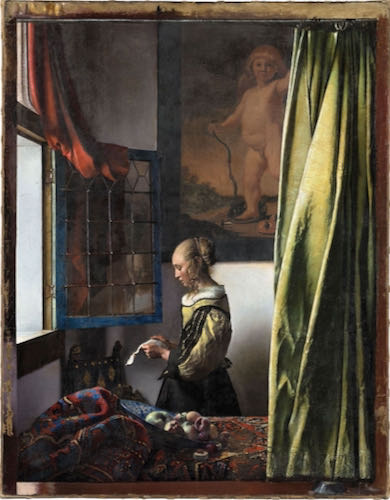
Vermeer’s “Girl Reading a Letter at an Open Window” – with or without the Cupid we like it?
ArtWizard 15.09.2021
Last week, with the opening of the exhibition showing of the restored painting of Vermeer, the art lovers have been struck by Cupid’s arrow, as they saw for the first time the completed restoration of Johannes Vermeer’s Girl Reading a Letter at an Open Window with the Cupid in the background. The new view of the painting has been released by the Gemäldegalerie Alte Meister in Dresden. The painting contains, in fact, another painting inside, where the wall across the girl reading the letter reveals a full-length classical Cupid figure. Such an image of Cupid made in the Renaissance style with an arrow pointing directly to the viewer of the canvas changes completely the composition in one of Vermeer’s most famous paintings. This change is so big, that some of the Vermeer lovers are shocked or even not sure if they agree with such an addition.


Johannes Vermeer, Girl Reading a Letter at an Open Window, sirca 1657-59 (Without and with Cupid)
The painting has been in the Dresden museum collection for more than 250 years and the hidden Cupid had been known about for a long time since an x-ray in 1979 and infrared reflectography in 2009 revealed that there is some figure painted on the wall under layers. It had been assumed that the artist himself painted it and covered over at a later moment the figure of Cupid.
Further to the initial x rays and paint analysis, the restoration experts, that a previous version of Vermeer’s canvas actually contained a painting within a painting: an image of Cupid on the wall behind the young girl reading the letter, gazing out at the viewer of the canvas. For some experts, the new Cupid figure revealed that the artist meant to show that the girl is in fact reading a love letter.
“With the recovery of Cupid in the background, the actual intention of the Delft painter can be recognized,” director Stephan Koja, the director of Gemäldegalerie Alte Meister, told the Telegraph. “Beyond the ostensibly amorous context, it is about a fundamental statement about the nature of true love. Now we understand it as a key image in his oeuvre.”
What’s less simple to understand is why the Cupid was painted over by someone other than Vermeer in the first place. The researchers who made the discovery that Vermeer himself hadn’t painted the Cupid figure, came to that conclusion in an interesting way. When a major restoration project began in May 2017, conservators discovered that the paint on the wall in the background of the painting, covering the naked Cupid, had in fact been added by another person.
When layers of varnish from the 19th century began to be removed from the painting, the conservators discovered that the “solubility properties” of the paint in the central section of the wall were different from those elsewhere in the painting. Following further investigations, including tests in an archaeometry laboratory, it was discovered that layers of binding agent and a layer of dirt existed between the image of Cupid and the overpainting. The conservators concluded that several decades would have passed between the completion of one layer and the addition of the next and therefore concluded that Vermeer could not have painted over the Cupid himself. No discovery as to who in fact painted the Cupid figure has been made yet.
So, the question remains, knowing that the Cupid wasn’t probably Vermeer’s idea, how the art lovers prefer to see the painting?
